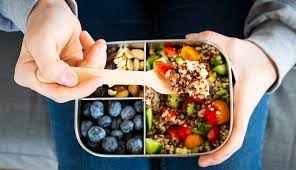It doesn’t matter if you have been a health-conscious eater all your life or if you have fallen off the nutritional wagon in recent years; it is important to review your diet after 50. Experts say it’s worth being more selective about what you eat and ensuring you get enough nutrition. Christine Rosenbloom is a registered dietitian, nutritionist, and professor emerita of Georgia State University. She coauthored Food & Exercise Over 50. “Unless we are looking to see weight gain, there is less space for drinking margaritas or snacking on chips. That’s what nobody wants.”
You need to adapt to a slower metabolism and compensate for a tendency for bones, bowel function, and mass muscle decline (around 1% per year up to age 65, then the loss can double). Marie Bernard, M.D. is the deputy director of NIA and senior geriatrician at NIA. A healthy diet can reduce blood pressure, lower the risk of developing heart disease, and prevent diseases like diabetes and cancer.
Joseph Gonzales, a registered dietitian at Mayo Clinic, says that healthy eating is possible if you remember that food works together in concert. You don’t need the whole orchestra to create a great musical piece. But, if you add these seven foods into your orchestra, you can make your diet more healthy.
Berries
Because they are high in fiber, vitamin A, anti-inflammatory, antioxidant flavonoids, and vitamin C, berries provide “one-stop nutrition” for over-50s. Nancy Farrell Allen (registered dietitian nutritionist) is a spokesperson for the Academy of Nutrition and Dietetics. “Fiber helps us keep our regular, manage weight, and protect against diseases such as diabetes, heart disease, and cancer,” she says. Women 50 years and older should consume 21 grams per day while men over 51 should eat 30g.
Also, berries are good for our brains as we age. Allen states that berries contain powerful antioxidants that can improve motor skills and short-term memory. They are an important part of the MIND diet which focuses on foods that combat neurodegenerative delay. Other brain-healthy foods include beans, whole grains and nuts. Last year, a Tufts University study looked at the 20-years of eating habits of 2,800 older people. It found that those who ate fewer flavonoid-rich foods such as tea, berries, and apples were twice to four times more likely than those who ate a high amount of tea and fruits.
Join AARP to save 25% and sign up for Automatic Renewal your first year. Instant access to all the discounts, programs, and services you need. Alicia Arbaje M.D. is an associate professor of medicine in the Johns Hopkins School of Medicine Division of Geriatric Medicine and Gerontology. She highlights the wild blueberry, usually sold in the frozen foods section. They have three to four times the antioxidants as conventional blueberries. You can add them to your oatmeal and smoothies.
Dark-green leafy vegetables
Bernard from the NIA says that our bones become softer as we age. They also need calcium. “That’s something that you can get from low-fat dairy and dark-green leaves vegetables,” Bernard of the NIA says. A March 2018 Australian study in the Journal of Nutrition showed that people who consumed just one cup of nitrate-rich leafy green vegetables per day had stronger lower limbs. A Danish study found that people who ate these vegetables had a 12 to 26 percent lower chance of developing heart disease. It was also conducted with over 50,000 people for 23 years.
Seafood
Older people need protein to keep or gain muscle. Fish like salmon, cod and tuna are good sources of protein. Bernard suggests that you consume five to six ounces of protein per day. This includes seafood and poultry and nuts, seeds, legumes, soy products, and lean meats. Studies have shown that older people need to be more aware of their protein intake, as their bodies are less efficient at using it than middle-aged individuals.
Fish is also rich in vitamin B12, a nutrient that can only be found in animal foods. As we age, it becomes more difficult to absorb. Rosenbloom states that seafood also contains omega-3 fatty acids. A weekly intake of two to three meals a week can reduce the risk of death from bulk chronic diseases by around 17 percent.
Nuts and seeds
Rosenbloom states that all nuts may not be the same, but they are all good for you. Rosenbloom says that nuts are rich in protein and fiber and help you feel full.
Healthy fats can also be found in nuts and seeds. Allen says that ALA omega-3 fatty acid is found in walnuts, flax meal, and chia seeds. These are then converted into EPA and DHA omega-3 fatty oils.
Cottage cheese
These little high-calcium curds could get a permanent spot on your weekly menu. Rosenbloom says that “Cottage cheese, which is rich in whey protein and stimulates muscle protein synthesis,” is an excellent choice. This is something that athletes know: many drink whey protein shakes after a hard workout. Instead of drinking whey protein, try cottage cheese.
It also contains high levels of vitamin D and calcium. You can find phosphorous in nuts, legumes, cereals, grains, and magnesium in nuts seeds, legumes, cereals, and grains.
Beans and legumes
What makes superfoods so special? Gonzales says beans help lower cholesterol. “Beans are high in fiber and protein and low-calorie. They also have iron, potassium, and magnesium. You can choose dry beans or low sodium canned varieties. If you don’t have either, Rosenbloom says that you can drain and rinse regular beans to reduce sodium by 41%. (And don’t forget about garbanzos! Gonzales recommends hummus for healthy snacks.
Water
Water is not food. It’s true. However, you have to be more mindful of how much water you drink as you get older. Rosenbloom says that as we age, our thirst mechanisms become less efficient. He recommends monitoring your water intake, especially when outside gardening or in hot, humid conditions. Bernard points out that drinking more water can counteract the decline in bowel function as we age. Remember that we often think we are hungry when we are thirsty.



